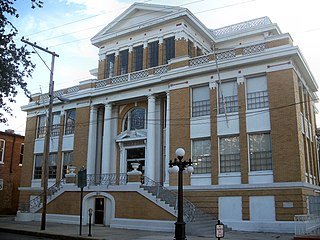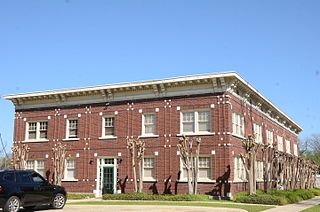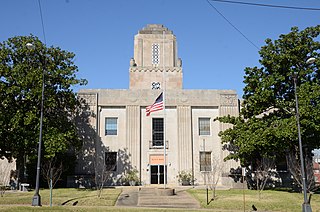
El Circulo Cubano de Tampa is an American historic building constructed in 1917 to serve as a gathering place for Cuban immigrants in Ybor City, Tampa, Florida. It was designed by Tampa architect M. Leo Elliott. It is located at Palm Avenue and 14th Street. On November 15, 1972, it was added to the U.S. National Register of Historic Places. On April 18, 2012, the AIA's Florida Chapter placed the building on its list of Florida Architecture: 100 Years. 100 Places as Cuban Club, Ybor City.

The Confederate State Capitol building in Washington, Arkansas was the capital of the Confederate state government of Arkansas, during 1863–1865, after Little Rock, Arkansas fell to Union forces in the American Civil War. It is located within Historic Washington State Park, and is a National Historic Landmark.
At their peak, there were six Chinese Society Halls on Maui. Operated by the Gee Kung Tong Society, these halls were created to provide services to immigrant Chinese workers, mostly working for the sugarcane plantations. All provided religious and political help, in addition to mutual aid. Only the Wo Hing Society Hall in Lahaina and the Ket Hing Society Hall in Kula have survived. Both were placed on the Hawaii State Register of Historic Places on July 30, 1982, and placed on the National Register of Historic Places on November 15, 1982. The Chee Kung Tong Society Hall was placed onto both State and Federal registers, but collapsed in 1996.

The Lincoln American Tower is a 22-story building located at the corner of North Main and Court streets in Memphis, Tennessee. It is also a historical landmark, one of the first steel frame skyscrapers built in Memphis. The tower underwent a six-year refurbishing project starting in 2002, and despite a fire in 2006, is now open and accepting tenants.
The University of Arkansas Campus Historic District is a historic district that was listed on the National Register of Historic Places on September 23, 2009. The district covers the historic core of the University of Arkansas campus, including 25 buildings.

The Old Union School is a historic school building at 504 Old Union Road in Birdell, Arkansas. It is a single-story wood frame Plain Traditional structure, with a corrugated metal gable roof and a stone foundation. Built in 1913, it is one of the few older structures in Birdell, and the only one-room schoolhouse in southwestern Randolph County. The building was used as a school until 1941, and saw only occasional use for other community purposes until 1991, when it underwent a major restoration. It is now used as a community hall.

The Masonic Temple of El Dorado, Arkansas is located at 106-108 North Washington Street, on the west side of the courthouse square. The four-story masonry building was built in 1923–24 to a design by Little Rock architect Charles S. Watts. It is one of a small number of buildings in Arkansas with Art Deco styling influenced by the Egyptian Revival. This particular styling was likely influence by the 1922 discovery of the Tomb of Tutankhamun.

The Mount Moriah Masonic Lodge No. 18 is a historic building in Lisbon, Arkansas, US. The two-story wood frame lodge building was built in 1858, and is virtually unaltered. It has several distinctive construction features, including 12" by 12" timber posts that rise the full two stories at its corners; this feature is believed to be unique in the state. It was built as a meeting hall a local chapter of Freemasons, and is the oldest purpose-built Masonic hall still used for that purpose in Arkansas.

Bradley County Courthouse is a courthouse in Warren, Arkansas, United States, the county seat of Bradley County, built in 1903. It was listed on the National Register of Historic Places in 1976. The courthouse was built using two colors of brick and features a 2½ story clock tower.

Albert Oscar Clark (1858–1935), commonly known as A.O. Clark, was an American architect who worked in Arkansas in the early 1900s.

Union Station is a former railroad station at East 4th Ave. and State St. in Pine Bluff, Jefferson County, Arkansas. The station was originally at the union of the Cotton Belt and Iron Mountain railroads, and now houses the Pine Bluff/Jefferson County Historical Society museum. It is a single-story brick building, with a hip roof whose long eaves are supported by iron columns and half-truss brackets. The station was built in 1906 by the Iron Mountain Railroad. It had been a stop on the St. Louis Southwestern's Lone Star (Memphis-Dallas), and also on the railway's St. Louis-Dallas trains.

The El Dorado Apartments in El Dorado, Arkansas are a historic apartment house at 420 Wilson Place. The two story brick and limestone building was designed by Louisiana architect Cheshire Peyton, and built in 1926 in response to the discovery of oil in the area and the ensuing economic boom. It houses 24 small efficiency units, designed for use by the transient but wealthier workers and managers of the oil-related economy. The building has limestone window sills, and rows of brick-inlaid limestone squares between the windows. The cornice of the flat roof is decorated with brick dentil moulding and modillions.

The Exchange Bank building, formerly the Lion Oil Headquarters, is a historic commercial building at Washington and Oak Streets in El Dorado, Arkansas. Built in 1926–27, the nine-story building was the first skyscraper in Union County, and it was the tallest building in El Dorado at the time of its listing on the National Register of Historic Places in 1986. It was designed by the Little Rock firm of Mann & Stern, and is an eclectic mix of Venetian-inspired Revival styles. It was built during El Dorado's oil boom, and housed the headquarters of Lion Oil. It was included in the El Dorado Commercial Historic District in 2003.

The El Dorado Commercial Historic District encompasses the historic commercial heart of downtown El Dorado, Arkansas. The city serves as the seat of Union County, and experienced a significant boom in growth during the 1920s, after oil was discovered in the area. The business district that grew in this time is anchored by the Union County Courthouse, at the corner of Main and Washington Streets, where the Confederate memorial is also located. The historic district listed on the National Register of Historic Places in 2003 includes the city blocks surrounding the courthouse, as well as several blocks extending east along Main Street and south along Washington Street. Most of the commercial buildings are one and two stories in height and are built of brick. Notable exceptions include the Exchange Bank building, which was, at nine stories, the county's first skyscraper, and the eight-story Murphy Oil building. There are more than forty contributing properties in the district.

The Municipal Building, or City Hall, of El Dorado, Arkansas is located at 204 North West Street.

The Woodmen of Union Building is a historic commercial building at 501 Malvern Avenue in Hot Springs, Arkansas. It is a four-story structure, built mainly out of brick and ceramic blocks, although its southeastern section has upper levels with wood framing and finishing. Its main facade has an elaborate projecting entrance portico, with the entrance set in an elliptical-arch opening supported by fluted pilasters. The interior retains significant original features, including a bank vault, marble wainscoting, and a 2,500-seat auditorium. It was built in 1923-24 for the Supreme Lodge of the Woodmen of Union, an African-American social organization, which operated it as a multifunction bathhouse, hotel, hospital, bank, and performance venue. It was purchased in 1950 by the National Baptist Association.

Ellis Hall is an administration building on the campus of Hendrix College in Conway, Arkansas. It is basically a large two-story house, with Craftsman styling, built in 1913 to a design by Charles L. Thompson, who also designed several other buildings on the Hendrix campus. The building served as the college's President's House until 1980, and now houses the college's admissions and financial aid offices.

The Union Life Building is an eleven-story high-rise at 212 Center Street in downtown Little Rock, Arkansas. It was designed by Arkansas architect George R. Mann in the style of the Chicago school, and was built 1911–16. It is T-shaped in footprint, with brick curtain-wall construction on all sides except the main facade, which is faced in terra cotta tile and glass. The first two levels of the facade are crowned by an ornate cornice, its second-level segmented-arch windows echoed in windows and an arch design at the top of the building. It is Little Rock's only major example of Chicago style commercial architecture.

The Union Church and School is a historic combination church and school in rural Logan County, Arkansas. It is located northeast of Paris, on the south side of Union Road at its junction with Clayton Lane. It is a vernacular single-story L-shaped wood-frame structure, with a gabled roof, weatherboard siding, and a stone foundation. The right side of the building, a cross-gable section, was built about 1895, and the left portion was built about 1922. It served the surrounding community as a two-room school until 1948, and as a Presbyterian church until 1958.

The Waverly East Bremer Avenue Commercial Historic District is a nationally recognized historic district located in Waverly, Iowa, United States. It was listed on the National Register of Historic Places in 2014. At the time of its nomination it contained 53 resources, which included 41 contributing buildings, and 12 non-contributing buildings. The historic district covers a portion of the city's central business district between the Cedar River on the west and the former right-of-way for the Chicago Great Western Railway on the east.




















